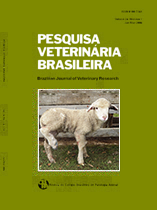 |
|
|
|
Year 2016 - Volume 36, Number 10
|

|
Identification of differentially expressed transcripts by Pasteurella multocida iron-starved condition, 36(10):965-970
|
ABSTRACT.- Silva M.I.V., Chitarra C.S., Oliveira Filho J.X., Morés N., Ito A.T.H., Rocha I.S.M., Nakazato L. & Dutra V. 2016. [Identification of differentially expressed transcripts by Pasteurella multocida iron-starved condition.] Identificação de transcritos diferencialmente expressos por Pasteurella multocida em condições de privação de ferro. Pesquisa Veterinária Brasileira 36(10):965-970. Laboratório de Microbiologia e Biologia Molecular Veterinária, Universidade Federal do Mato Grosso, Av. Fernando Corrêa da Costa 2367, Bairro Boa Esperança, Cuiabá, MT 78060-900, Brazil. E-mail: valdutra@ufmt.br
Iron (Fe) is an essential element and the ability to acquire it in vivo has been described in several pathogens as virulence factors. Global analyses of transcripts during iron deprivation have been described by microarray studies, however recently RNA-seq analysis showed superior results. The high pathogenic swine strain of Pasteurella multocida (BRMSA 1113) was grown in two conditions with different concentrations of Fe (control and deprivation) in order to analyze the differentially expressed transcripts. The total RNA of the two conditions was extracted and sequenced by new generation Ion Torrent plataform. Data were analyzed in Ion Reporter™ Software and processed in Rockhopper software. Sequence analysis shows 1,341,615 readings with median length of 81pb, with 96% of alignment to the reference genome Pasteurella multocida strain 3489, and 98.8% accuracy. Reads mapping to genome of P. multocida in these two conditions detected 2,652 transcripts, which 177 (6.7%) were differentially expressed, with 93 in the control condition (Fe+) and 84 provided with iron deprivation condition (Fe-). In condition (Fe-), differential expressed transcript profile were associated to function of cellular transport (fbpABC, high-affinity Fe2+/Pb2+ permease and periplasmic protein probably involved in hight-affinity Fe2+), transcptional regulators and hypothetical proteins. The control condition (Fe+) shows differential expressed transcripts profile associated to RNA anti-sense (asRNA) energetic metabolism genes (fructose-1,6-bisphosphatase). The study showed that the Fe restriction increases the expression of genes involved in cellular transport, transcriptional regulators, hypothetical and unknown proteins, and also allowed the identification of High-affinity Fe2+/Pb2+ permease e Periplasmic protein probably involved in high-affinity Fe2+, that constitute a possible alternative route for Fe absorption. |
| |
|
|
| |
|
 |